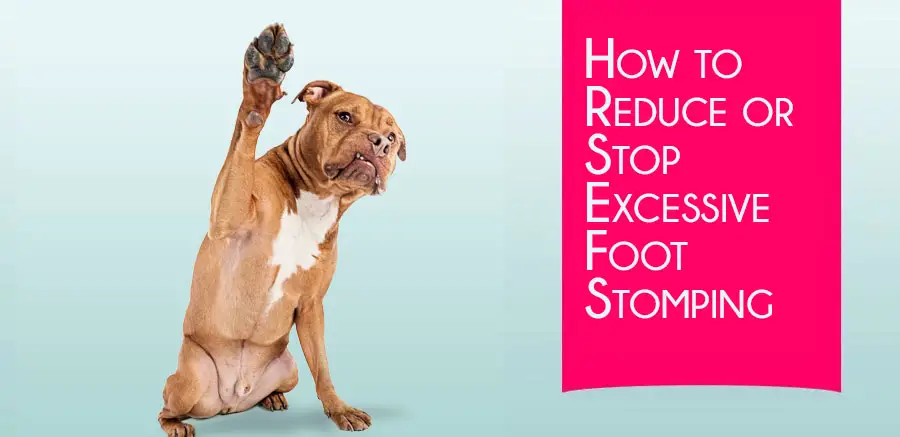It starts with a slight lift of the paw, and then down it comes – your dog deliberately stomps their foot on the ground. This abrupt, forceful motion may seem peculiar or random. But in reality, foot stomping serves a purpose for dogs.
This common behavior could stem from communication, territorial marking, medical issues, or even boredom. Understanding the root cause is key to addressing excessive or inappropriate foot stomping.
In this comprehensive guide, we’ll explore the top reasons behind paw stomping in dogs. You’ll also learn effective solutions to curb the behavior.
Whether your dog seems to stomp and kick their feet excessively, or just does an occasional stomp, discovering the source of this quirky habit is essential. Let’s get insight into what makes dogs channel their inner bulls and stomp away!
Suggested reading: why does my dog poop with his leg up (new tab)
7 Reasons why dogs stomp their feet
Stomping of the feet is actually a normal canine behavior, when done moderately. There are several motivations behind the movement.
Marking Their Territory
When dogs stomp their feet, one intriguing reason behind this behavior is territorial marking.
Dogs have scent glands located in their paws, and the act of stomping helps to release these scents onto the ground. This behavior serves as a form of communication with other dogs, essentially leaving a message that says, “I was here.”
Territorial marking through foot stomping can be particularly noticeable in certain situations.
For example, when a dog is introduced to a new environment, you might observe them stomping more frequently as they explore their surroundings.
This is their way of getting acquainted with the new space and asserting their presence. Similarly, if there are other pets in the household, a dog might use foot stomping to establish their position within the social hierarchy.
It’s important for pet owners to recognize this behavior as a natural instinct rather than a defiance or misbehavior. However, if the foot stomping becomes excessive or leads to destructive behavior, it may be necessary to address it through training and behavior modification.
Seeking Attention
Dogs are social animals that thrive on interaction with their human companions. One of the reasons a dog might stomp their feet is to capture their owner’s attention.
This behavior can arise when a dog feels neglected or desires more interaction, whether it’s for play, affection, or even food.
When a dog learns that certain behaviors elicit a response from their human, they’re likely to repeat those behaviors.
If a dog stomps their feet and it results in their owner looking their way, giving them a treat, or starting a play session, the dog will remember this outcome. Over time, foot stomping can become a go-to method for seeking attention, especially if it has been effective in the past.
Playing and Excitement

Dogs are known for their exuberance and boundless energy, especially during playtime.
Foot stomping can be a natural expression of their enthusiasm and excitement. It’s their way of releasing built-up energy and signaling their joy in the moment.
During play, dogs may engage in a variety of behaviors, including running, jumping, barking, and yes, stomping their feet. This behavior often accompanies moments of high arousal and anticipation. It’s as if they can’t contain their excitement and need an outlet for their exuberance.
Foot stomping in the context of play is typically a positive behavior. It shows that your dog is fully engaged and enjoying the interaction. It can also serve as a form of communication, signaling to other dogs or even to their human playmates that they are ready and eager to continue the fun.
Stomping their feet during play can be seen in various scenarios, such as when dogs are engaged in a game of fetch, chasing each other, or playing with toys. It’s a way for them to release their energy and express their enthusiasm for the activity.
Signaling Discomfort or Irritation
Foot stomping can also be a sign that something is bothering your dog, such as a thorn in their paw or an irritating bug bite. This behavior is their way of trying to remove the discomfort. If you notice your dog stomping one foot more than the others or continuously licking a paw after stomping, it’s worth a closer inspection to ensure there’s nothing causing them harm.
Hunting Instincts
For breeds with strong hunting instincts, foot stomping can be a reflection of their ancestral behaviors. This action can mimic the motion of flushing out prey from hiding spots. While domestic dogs may not need to hunt, these instincts can still surface in playful or curious moments.
How to Respond to Your Dog’s Foot Stomping
Understanding the context of your dog’s foot stomping is key to responding appropriately. If it’s a territorial mark, acknowledging their behavior or redirecting it to a more appropriate outlet, like a toy or a designated scratching post, can help. For attention-seeking stomps, ensure you’re providing enough interactive playtime and affection, balanced with training to encourage calmness.
In cases of discomfort or irritation, a thorough check of their paws and a visit to the vet might be necessary to address any underlying issues. And for those driven by excitement or play, joining in on the fun can strengthen your bond.
Remember, if you’re ever unsure about the cause or if the behavior becomes excessive, consulting a professional trainer or behaviorist is always a wise decision.
Training and Managing Foot Stomping Behavior

Understanding why dogs stomp their feet is the first step. The next is learning how to manage or modify this behavior, especially if it becomes excessive or problematic. Through training and the right approach, you can guide your dog towards more desirable behaviors.
Positive Reinforcement Techniques
Positive reinforcement is a powerful tool in dog training, encouraging desired behaviors through rewards. Whether you’re looking to encourage or discourage foot stomping, the key is to understand what motivates your dog and use that as the basis for reinforcement.
Encouraging Appropriate Foot Stomping: If foot stomping is part of a healthy expression of excitement or play, you can encourage it in a controlled manner.
For instance, during playtime, prompt your dog to stomp their feet with a specific command like “stomp,” and immediately reward them with play, affection, or treats. This not only reinforces the behavior but also helps you control when and how it happens.
Discouraging Excessive or Inappropriate Stomping: To discourage unwanted foot stomping, especially when seeking attention or due to anxiety, redirect your dog’s behavior towards a more positive action.
For example, teach them to sit quietly or use a toy when they want attention. Ignore the foot stomping and only provide attention or treats when they engage in the desired behavior. Over time, your dog will learn that calm behavior, not stomping, is what brings rewards.
Remember, consistency is crucial. Everyone in the household should respond to foot stomping in the same way to avoid confusing your dog.
When to Seek Professional Help
While many instances of foot stomping can be managed with consistent training, there are times when professional help may be needed:
- Persistent, Unexplained Stomping: If your dog continues to stomp their feet excessively without a clear cause, despite your training efforts, it might be time to consult a professional. There could be underlying issues, such as anxiety or discomfort, that a trained eye can help identify.
- Behavioral Issues: Sometimes, foot stomping is part of a broader range of behavioral issues, such as aggression, extreme anxiety, or destructive behaviors. In these cases, a professional dog trainer or a veterinary behaviorist can provide targeted strategies to address the root cause of the behavior.
- Lack of Response to Home Training: If your attempts to train or redirect your dog’s foot stomping behavior are unsuccessful, a professional trainer can offer new techniques and insights. They can also provide a structured training plan tailored to your dog’s needs.
Professional trainers and behaviorists bring a wealth of experience and knowledge to the table. They can offer personalized training sessions, behavior modification plans, and support to help you and your dog overcome challenges together.
FAQs About Dogs Stomping Their Foot
Foot stomping in dogs can raise several questions for pet owners. Below are concise answers to some of the most commonly asked questions about this behavior and its related aspects.
Why does my dog stomp their feet when they see other dogs?
Dogs may stomp their feet when they see other dogs as a way of communicating. It can be an expression of excitement, a play invitation, or a way to assert dominance. Observing the accompanying body language, like tail wagging or growling, can help clarify their intent.
Is foot stomping a sign of aggression in dogs?
Not necessarily. While foot stomping can sometimes be observed in situations where a dog is asserting dominance, it’s not a direct indicator of aggression.
More often, it’s linked to excitement, play, or territory marking. Aggression is usually accompanied by more explicit signs, such as baring teeth, growling, or a stiffened body posture.
Should I be worried if my dog suddenly starts stomping their feet?
A sudden onset of foot stomping, especially if it’s accompanied by other unusual behaviors or signs of distress, might warrant closer attention. It could indicate discomfort, irritation, or even an underlying health issue. If you’re concerned, a check-up with your vet can help rule out any medical problems.
How can I tell if my dog’s foot stomping is playful or something else?
Observing the context and your dog’s overall body language can provide clues. Playful foot stomping is usually accompanied by other signs of excitement, such as wagging tails, playful barks, and a relaxed body posture. If foot stomping appears in different contexts or alongside signs of discomfort or aggression, it may have another cause.
Do certain breeds of dogs stomp their feet more than others?
While any dog can exhibit foot stomping, breeds with strong hunting instincts or high energy levels may be more prone to this behavior due to their natural drive for activity and territory marking. However, individual personality and upbringing play significant roles in how frequently a dog engages in foot stomping.
Understanding the nuances behind foot stomping and other behaviors in dogs enhances our ability to communicate and connect with our furry friends. Always consider the context and consult with a professional if you’re unsure about your dog’s behavior.
Recap on why dogs stomp their feet
In summary, managing foot stomping behavior in dogs is about understanding the why behind the action and responding appropriately. Whether through positive reinforcement techniques at home or with the support of a professional, you can guide your dog towards healthier behaviors, strengthening your bond in the process.



